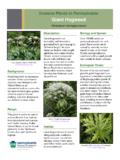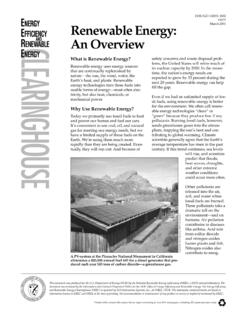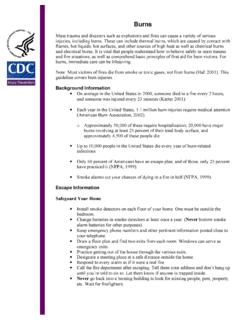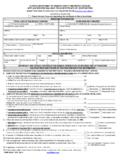Transcription of Coal in Pennsylvania
1 Educational Series 7. IN Pennsylvania . COMMONWEALTH OF Pennsylvania . DEPARTMENT OF. CONSERVATION AND NATURAL RESOURCES. BUREAU OF. TOPOGRAPHIC AND GEOLOGIC SURVEY. COMMONWEALTH OF Pennsylvania . Edward G. Rendell, Governor DEPARTMENT OF. CONSERVATION AND NATURAL RESOURCES. Michael DiBerardinis, Secretary OFFICE OF CONSERVATION AND ENGINEERING SERVICES. Larry G. Williamson, Deputy Secretary BUREAU OF TOPOGRAPHIC AND GEOLOGIC SURVEY. Jay B. Parrish, Director Educational Series 7. Coal in Pennsylvania by William E. Edmunds Pennsylvania GEOLOGICAL SURVEY. FOURTH SERIES. HARRISBURG. 2002. When reproducing material from this book, please cite the source as follows: Edmunds, W.
2 E., 2002, Coal in Pennsylvania (2nd ed.): Pennsylvania Geological Survey, 4th ser., Educational Series 7, 28 p. Pennsylvania web site: Department of Conservation and Natural Resources web site: Bureau of Topographic and Geologic Survey web site: Illustrations drafted by John G. Kuchinski and Albert E. Van Olden Edwin F. Koppe (deceased) is gratefully acknowledged for his help in the preparation of the first edition of this report. Thanks also to Clifford H. Dodge (Bureau of Topographic and Geo- logic Survey) for providing updated information in the Introduction . and Coal Resources of Pennsylvania sections for the third printing.
3 First Edition, 1968. Fifth Printing, April 1981. Second Edition, May 2002. Third Printing, Slightly Revised, June 2006. COAL IN Pennsylvania . by William E. Edmunds INTRODUCTION. Noted geologist David White once said, Coal is like character the deeper you go into it, the more interesting it becomes. Except in areas where it is mined or is being transported in long strings of railroad coal cars, coal is rarely seen in modern America. Nevertheless, it is a pres- ent and important factor in everyone's daily life. It is burned to generate our electricity and to make our iron and steel. It is refined to make medi- cines, plastics, synthetic rubber, fertilizer, cosmetics, food products, paint, dyes, and even the fibers of our clothes.
4 The history of coal is a long one, stretching back 25 centuries or more. In the fourth century , the Greek philosopher Aristotle mentioned coal in his book, Meteorology. Coal was commonly used in Europe as early as the thirteenth century; however, with the invention of the steam engine, which provided the powerful lifting, drawing, and pumping equip- ment necessary for large-scale mining, coal became a major industry. The earliest known mention of coal in North America is of that on Cape Breton Island, Canada, in 1672. A map made by the explorer Joliet in 1673 shows a coal location in Illinois.
5 The earliest note of coal in Pennsylvania appears on a map made by John Pattin in about 1752, which indicates coal at a site along the Kis- kiminetas River a few miles below the present community of Saltsburg 1. 2 COAL IN Pennsylvania . on the Indiana-Westmoreland County line. The earliest record of actual coal mining in Pennsylvania is shown on a Plan of Fort Pitt and Parts Adjacent in 1761. Fort Pitt was located in what is now downtown Pitts- burgh where the Allegheny and Monongahela Rivers join to form the Ohio River. The mine was located across the Monongahela River near the top of Coal Hill (now called Duquesne Heights).
6 These early miners removed the first few tons of coal from the fabulous Pittsburgh seam, which has been called, with considerable justice, the world's most valuable single mineral deposit. The first mine superintendent was Major Edward Ward of the Fort Pitt garrison. The Fort Pitt mine was also the site of another less enviable first . the first mine fire. In 1766, the Presbyterian minister Charles Beatty wrote: A fire being made by workmen not far from where they dug the coal, and left burning when they went away, by the small dust communicated itself to the body of the coals and has set it on fire, and has been burn- ing almost a twelve month entirely under ground.
7 The first clear record of anthracite coal appears on a map prepared by John Jenkins, Sr., in 1762, which showed stone coal in two places. The first use of anthracite was by the Gore Brothers in their blacksmith shop at Wilkes-Barre in 1769. The coal industry grew slowly but steadily from those early days, match- ing the growth of American industry. The great expansion in coal mining took place following the Civil War, when coal powered the vast industrial revolution of the late nineteenth and early twentieth centuries. Pennsylva- nia's great reserves of high-quality coal, including coking coal, were di- rectly responsible for the presence of our iron and steel, chemical, glass, and metal-fabricating industries.
8 Much of the railroad network in Penn- sylvania was specifically constructed to transport coal. The Pennsylvania coal industry saw its greatest year in 1918, when 330,000 miners produced a staggering 277 million tons of coal worth $705 million at that time. World War I was at its height, American in- dustry was straining every muscle, and virtually everything that required power ran on coal industry, railroads, steamships, electrical generation, and most home and commercial heating. The years following World War I, which led into the Great Depres- sion of the 1930s, saw American industry virtually grind to a stop and coal requirements decline accordingly.
9 In 1944, during World War II, coal production again peaked at almost 209 million tons, but declined steadily thereafter until 1961 when 80 million tons was mined. Something else had WHAT IS COAL? 3. happened. Coal was assailed on all sides by vigorous competitors. Most of the home and commercial heating market was lost to oil and natural gas. Railroads and steamships converted to oil. New processes displaced coal from part of the basic metal-smelting industry, and although coke is still required in iron making, improved technology decreased the amount of coke needed to produce a ton of iron. Coal production stabilized at between 80 and 95 million tons per year from 1961 to 1981, then fell irregularly to 63 million tons in 1993, the low- est figure since 1885.
10 This decline reflected the severe contraction of coal markets in coke production, retail and commercial sales, and industrial use, as well as the depletion of many of the most accessible coal deposits and more stringent environmental regulation. Although sales to electric utilities grew somewhat, much of the potential there was lost to nuclear energy. With continued increasing demand for electricity and the end of new nuclear plant construction, coal production has increased rapidly in the past several years, reaching a high of 87 million tons in 1998. Output in 2004 totaled 75 million tons. Fifty percent of Pennsylvania production now comes from large underground mines in Greene County.














